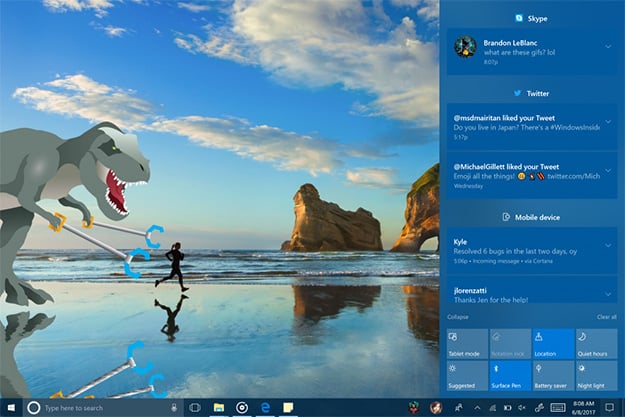Microsoft Confirms Windows 10 Temporarily Disables Third Party Antivirus Software After Major Updates
Computer security has always been somewhat of a hot topic, though it has intensified in recent weeks in the wake of the global WannaCry ransomware outbreak. In response, Microsoft has issued a series of updates to Windows, including legacy versions no longer supported such as Windows XP and Windows Vista. Microsoft also used the heightened focus on PC security as an opportunity to explain its stance on antivirus software and how Windows 10 handles third-party AV programs.
You might recall that Kaspersky, one of the more popular third-party security outfits, took Microsoft to task over the way Windows 10 prioritizes its own built-in Windows Defender software over alternative AV solutions. Kaspersky even filed an antitrust complaint in Europe after filing a complaint last year with the Russia's Federal Antimonopoly Service (FAS). Among the list of grievances Kaspersky outlined is that Windows 10 takes every opportunity it can to disable third-party AV programs.

Microsoft addressed that concern (and others) in a blog post detailing its partnership with third-party AV makers and how they are collectively working to protect Windows 10 customers. In doing so, Microsoft did admit to disabling third-party AV software on occasion, though only in specific cases.
"Because AV software can be deeply entwined within the operating system, we doubled down on our efforts to help AV vendors be compatible with the latest updates," Microsoft said, adding that when the Windows 10 Creators Update released on April 11, around 95 percent of Windows 10 PCs had an AV program installed that was already compatible.

"For the small number of applications that still needed updating, we built a feature just for AV apps that would prompt the customer to install a new version of their AV app right after the update completed. To do this, we first temporarily disabled some parts of the AV software when the update began. We did this work in partnership with the AV partner to specify which versions of their software are compatible and where to direct customers after updating," Microsoft explained.
The bold text was done on our part for emphasis, and not by Microsoft. It highlights one of the biggest complaints Kaspersky has with Microsoft and Windows 10. According to Kaspersky, an independent developer typically needs around two months after receiving a Release To Manufacturing (RTM) build to fine-tune their AV software.
"Earlier, Microsoft would give us the RTM version in good time, but as of late this has been reduced to a couple of weeks before releasing to the public," Kaspersky lamented in a blog post of its own. "Accordingly, we and all other developers need to rush to ensure compatibility before the public launch of the OS."
From Microsoft's vantage point, the policies regarding third-party AV software are there for the greater good of its customers. Part of that entails having "always on" protection, which means sometimes having to enable Windows Defender on systems where a third-party AV program is installed, such as when a subscription expires.
As always, the truth probably lies somewhere in the middle.
You might recall that Kaspersky, one of the more popular third-party security outfits, took Microsoft to task over the way Windows 10 prioritizes its own built-in Windows Defender software over alternative AV solutions. Kaspersky even filed an antitrust complaint in Europe after filing a complaint last year with the Russia's Federal Antimonopoly Service (FAS). Among the list of grievances Kaspersky outlined is that Windows 10 takes every opportunity it can to disable third-party AV programs.

Microsoft addressed that concern (and others) in a blog post detailing its partnership with third-party AV makers and how they are collectively working to protect Windows 10 customers. In doing so, Microsoft did admit to disabling third-party AV software on occasion, though only in specific cases.
"Because AV software can be deeply entwined within the operating system, we doubled down on our efforts to help AV vendors be compatible with the latest updates," Microsoft said, adding that when the Windows 10 Creators Update released on April 11, around 95 percent of Windows 10 PCs had an AV program installed that was already compatible.

"For the small number of applications that still needed updating, we built a feature just for AV apps that would prompt the customer to install a new version of their AV app right after the update completed. To do this, we first temporarily disabled some parts of the AV software when the update began. We did this work in partnership with the AV partner to specify which versions of their software are compatible and where to direct customers after updating," Microsoft explained.
The bold text was done on our part for emphasis, and not by Microsoft. It highlights one of the biggest complaints Kaspersky has with Microsoft and Windows 10. According to Kaspersky, an independent developer typically needs around two months after receiving a Release To Manufacturing (RTM) build to fine-tune their AV software.
"Earlier, Microsoft would give us the RTM version in good time, but as of late this has been reduced to a couple of weeks before releasing to the public," Kaspersky lamented in a blog post of its own. "Accordingly, we and all other developers need to rush to ensure compatibility before the public launch of the OS."
From Microsoft's vantage point, the policies regarding third-party AV software are there for the greater good of its customers. Part of that entails having "always on" protection, which means sometimes having to enable Windows Defender on systems where a third-party AV program is installed, such as when a subscription expires.
As always, the truth probably lies somewhere in the middle.

